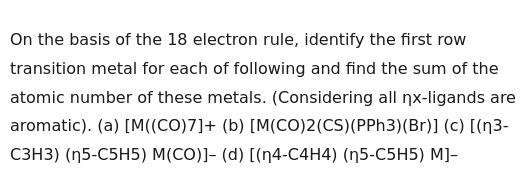Question
Question: On the basis of the 18 electron rule, identify the first row transition metal for each of following ...
On the basis of the 18 electron rule, identify the first row transition metal for each of following and find the sum of the atomic number of these metals. (Considering all ηx-ligands are aromatic). (a) [M((CO)7]+ (b) [M(CO)2(CS)(PPh3)(Br)] (c) [(η3-C3H3) (η5-C5H5) M(CO)]– (d) [(η4-C4H4) (η5-C5H5) M]–

96
Solution
The 18-electron rule is used to predict the stability of transition metal complexes, particularly organometallic compounds. The rule states that stable complexes tend to have 18 valence electrons around the metal center. The total electron count is the sum of the valence electrons contributed by the metal and the ligands, adjusted for the overall charge of the complex. We will use the Neutral Atom Method for electron counting.
For the first-row transition metals (Sc, Ti, V, Cr, Mn, Fe, Co, Ni, Cu, Zn), the number of valence electrons contributed by the neutral metal atom is equal to its group number (or the sum of s and d electrons).
- Sc (Group 3): 3 e⁻ (3d¹ 4s²)
- Ti (Group 4): 4 e⁻ (3d² 4s²)
- V (Group 5): 5 e⁻ (3d³ 4s²)
- Cr (Group 6): 6 e⁻ (3d⁵ 4s¹)
- Mn (Group 7): 7 e⁻ (3d⁵ 4s²)
- Fe (Group 8): 8 e⁻ (3d⁶ 4s²)
- Co (Group 9): 9 e⁻ (3d⁷ 4s²)
- Ni (Group 10): 10 e⁻ (3d⁸ 4s²)
- Cu (Group 11): 11 e⁻ (3d¹⁰ 4s¹)
- Zn (Group 12): 12 e⁻ (3d¹⁰ 4s²)
Ligand electron contributions (Neutral Atom Method):
-
CO (carbonyl): 2 e⁻ (sigma donor)
-
CS (thiocarbonyl): 2 e⁻ (sigma donor), analogous to CO
-
PPh₃ (triphenylphosphine): 2 e⁻ (sigma donor)
-
Br (bromide): 1 e⁻ (treated as a radical Br•, X-type ligand)
-
ηˣ-ligands: The electron contribution depends on the hapticity (ηˣ) and the nature of the ligand. The question states "Considering all ηx-ligands are aromatic". This implies we should consider the aromatic form of the ligand when determining its electron contribution.
- η³-C₃H₃ (cyclopropenyl): Aromatic form is cyclopropenyl anion (C₃H₃⁻), which has 4 π electrons. As a ligand, η³-C₃H₃⁻ contributes 4 e⁻.
- η⁵-C₅H₅ (cyclopentadienyl): Aromatic form is cyclopentadienyl anion (C₅H₅⁻), which has 6 π electrons. As a ligand, η⁵-C₅H₅⁻ contributes 6 e⁻.
- η⁴-C₄H₄ (cyclobutadiene): Aromatic form is cyclobutadiene dianion (C₄H₄²⁻), which has 6 π electrons. As a ligand, η⁴-C₄H₄²⁻ contributes 6 e⁻.
Let M be the number of valence electrons of the metal atom. The total electron count is M + Σ(ligand contributions) - charge. We set this equal to 18 and solve for M.
(a) [M(CO)₇]⁺
18 = M + 7 * (e⁻ from CO) - (+1)
18 = M + 7 * 2 - 1
18 = M + 14 - 1
18 = M + 13
M = 18 - 13 = 5
The first-row transition metal with 5 valence electrons is Vanadium (V), Z=23.
(b) [M(CO)₂(CS)(PPh₃)(Br)]
18 = M + 2 * (e⁻ from CO) + (e⁻ from CS) + (e⁻ from PPh₃) + (e⁻ from Br)
18 = M + 2 * 2 + 2 + 2 + 1
18 = M + 4 + 2 + 2 + 1
18 = M + 9
M = 18 - 9 = 9
The first-row transition metal with 9 valence electrons is Cobalt (Co), Z=27.
(c) [(η³-C₃H₃) (η⁵-C₅H₅) M(CO)]⁻
Using aromatic ligand contributions: η³-C₃H₃ contributes 4 e⁻, η⁵-C₅H₅ contributes 6 e⁻.
18 = M + (e⁻ from η³-C₃H₃) + (e⁻ from η⁵-C₅H₅) + (e⁻ from CO) - (-1)
18 = M + 4 + 6 + 2 + 1
18 = M + 13
M = 18 - 13 = 5
The first-row transition metal with 5 valence electrons is Vanadium (V), Z=23.
(d) [(η⁴-C₄H₄) (η⁵-C₅H₅) M]⁻
Using aromatic ligand contributions: η⁴-C₄H₄ contributes 6 e⁻, η⁵-C₅H₅ contributes 6 e⁻.
18 = M + (e⁻ from η⁴-C₄H₄) + (e⁻ from η⁵-C₅H₅) - (-1)
18 = M + 6 + 6 + 1
18 = M + 13
M = 18 - 13 = 5
The first-row transition metal with 5 valence electrons is Vanadium (V), Z=23.
The first-row transition metals are:
- (a) Vanadium (V), Z=23
- (b) Cobalt (Co), Z=27
- (c) Vanadium (V), Z=23
- (d) Vanadium (V), Z=23
The sum of the atomic numbers of these metals is 23 + 27 + 23 + 23.
Sum = 23 + 27 + 23 + 23 = 50 + 46 = 96.
The final answer is 96.
